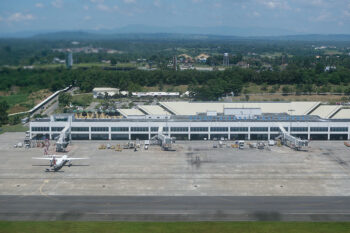 Principal Author: Dr. Maximilian Larena, PhD
Principal Author: Dr. Maximilian Larena, PhD
Collaborators: Carlo Ebeo, Adrian Albano, Edison Molanida, Trixie Cruz-Angeles, & Felipe Mendoza de Leon Jr.
Proceedings of the National Academy of Sciences of the U.S.A.
Lecture Presentation: ADDU Online Pakighinabi – June 2, 2021
DAVAO CITY (MindaNews / 03 June) – A most interesting forum took place online last June 2 which was sponsored by the the Ateneo de Davao University’s Internationalization for Mindanao Office AIM, in partnership with the Anthropology Department on the topic “Multiple Migrations to the Philippines in the last 50,000 years.”
The resource speaker was Dr. Maximilian Larena, a population geneticist and the principal Investigator of the Larena Lab, Human Evolution Program, in the Department of Organismal Biology, Uppsala University, Sweden. He is an esteemed alumnus of the Ateneo de Davao University who graduated cum laude with a Bachelor of Science degree in Biology in 2001.
This study would not have been accomplished if not for close to a hundred collaborators of Dr. Larena in the field including indigenous people themselves. A listing of these individuals and the agencies/institutions they represent show how extensive this research project was and how varied the participation of individuals and communities was. In terms of the sampling, there were 1,028 individuals involved, covering 115 indigenous communities.
This study has been extensively reviewed by the following independent organizations: Regional Ethics Review Board of Uppsala, Sweden; the Nature Journal; the Uppsala University Board for Investigation of Deviations from Good Research Practice; and the Ethics Review Appeals Board of Sweden. This has also been further endorsed by the National Commission for Culture and the Arts (NCCA) of the Philippines by then Chairperson Felipe Mendoza de Leon Jr., as well as fulfilling the regulations of UNESCO International Declaration on Human Genetic Data.
Reading both the main article and its summary twelve points, as well as listening to the lecture of Dr. Larena one is most impressed with the following: the extent of its being a multi-disciplinary study (tapping not just the field of natural sciences as in genomics, computational biology and geology but also a wide range of social sciences from archaeology to anthropology to linguistics and history).
The best feature of main contribution of the study is through the use of recent technological advances, which helped unlock the story of our past that is encoded in our genetic heritage, our DNA. Just imagine the extent of the DNA sampling that made possible the 2.3 million molecular DNA markers that were known to differ between populations. This resulted from the sampling of 1,028 individuals covering 115 indigenous communities.
Its methodology in combining quantitative and qualitative methods by way of engagement in both the laboratory and fieldwork is also very striking. The DNA sampling covers a wide range of our peoples across the archipelago. As such this study is a an excellent model of the kind of rigorous research that scholars in Philippine/Mindanao studies should be engaged in if they are to significantly add to knowledge production that has great value to all of us.
While Dr. Larena’s study’s timeline covers only the last 50,000 years, the reader is brought back to millennia of yore as it traced how modern-day humans arose out of Africa and spread across the globe. Because it does cover the past 50,000 years, Dr. Larena’s study provides a major contribution to reconstructing a time period of our ancestors’ and peoples’ history long before the conquest era.
The reality of Philippine historiography is that most historical narratives are voluminous from the conquest to the contemporary epochs. However, there is very little to help us revisit the more distant past, apart from the legends and myths that were passed on through oral tradition. With Dr. Larena’s study, we have additional information how our ancestors looked like as well as how they migrated across the islands and inter-bred with each other.
This study proves conclusively that the first “Filipinos”, that is, the first peoples who reached and settled down in the islands that would later on be named Philippines were the Negritos, reaching the archipelago 40 to 50,000 years ago. Some of them moved up to the north while others e.g. the Mamanuas’ ancestors settled in the south. Interesting to know that the Negritos have genealogical linkage to the Neanderthals as the study indicated a 3% DNA connection.
Then came the three major proto- (or basal) groups of our ancestors, namely: the Manobo-related and Sama-related groups (who both entered the southwestern part of the islands 12,000 years ago), followed by the Cordilleran-related groups 7 to 10,000 years ago following their split from indigenous Taiwanese. One reason for their migratory movement was the substantial changes in the landscape of the mythical Sundaland brought about by climate change. Which is saying, the phenomenon of climate change is not new.
Both the Manobo-related and Sama-related groups did inter-bred with Negritos. But the study did not indicate any historical interbreeding between the Cordillerans and the Negritoes.
So what about us lowland Filipinos including Tagalogs, Ilocanos, Bicolanos, Warays, Bol-anons, Cebuanos, Ilonggo, Karay-a and others. Dr. Larena’s study does not yet provide detailed information on this question, but during his lecture he said that most probably lowland Filipinos may have branched out from the Cordilleran-related groups although some may also have inter-bred with Manobo. As for the Islamized communities in the south, many of them could trace their lineage to the Sama-related groups.
So there: this study makes a very conclusive statement which many of us Mindanawon anthropologists have been claiming for sometime now, namely, that all of us Filipinos go back to indigenous ancestors. Thus, every Filipino, in one way or another, has indigenous roots! And no matter how we look down on the katutubo/Lumads in our midst (for let’s face it: there are many “racist” Pinoys whose gaze on the indigenous is quite patronizing), we cannot escape from the fact that by looking down on them and treating them as second-class citizens, we are spitting on the graves of our ancestors!
For this is the greatest irony in this archipelago as we celebrate this year’s quincentennial of the arrival of the first European colonizers – the first to settle down in the islands are the ones who today have the least access to the land and their resources as they continue to experience dislocation, victimization and marginalization. Worst of all are our Negritos (Ati, Ata, Aeta, Agta, Mamanua et al) and the various Sama-related groups especially the Sama D’laut (pejoratively still referred to as Badjao).
Here is how Dr. Larena summarized his study: “The complex demographic history of the Philippines presented here does not fit with the three-wave migration theory by Otley Beyer, nor does it fit with the models of either an exclusive out-of[1]Taiwan or out-of-Sundaland. Instead, we find that the Philippines were populated by at least five major waves of migration, starting with the Northern and Southern Negritos, who entered the Philippines after 40 to 50 thousand years ago to become the First Filipinos.
Thereafter by the Manobo-related groups entering Mindanao after 15 thousand years ago, and the Sama-related groups entering southwestern Philippines after 12 thousand years ago, both of which occurring around the time when there were substantial changes in the landscape of Sundaland brought about by climate change. Cordilleran-related groups likely arrived in the Philippines 7 to 10 thousand years ago following their split from Indigenous Taiwanese, around the time when there were climate change[1]induced geographical changes in the South China-Taiwan greater area.
Remarkably, some Cordillerans remained to be the only ethnic group in the Philippines who did not show evidence of genetic origins of the Filipino People historical interbreeding with Negritos, and consequently remained to be the only population in the world regarded as the un-admixed descendants of Basal East Asians We also find minor genetic signals of Papuan-related ancestry, Indian-related ancestry, and European ancestry in some ethnic groups.
The Papuan-related ancestry, dated more than ~2,500 year ago, is found among the coastal ethnic groups of southeastern Philippines such as Sangil and Blaan. The Indian[1]related genetic signal, dated 500 to 1000 years ago, is found among Sama Dilaut and other coastal Sama ethnic groups of southwestern Philippines, indicating some genetic impact of the historical Maritime Trading Network with India. Lastly, the European genetic signal, dated 150 to 450 years ago, is found in only 1% of all individuals investigated, indicating a limited genetic legacy of the Spanish Colonial Period.
In this work, we present an intricate prehistory of the Filipino people that is characterized by series of encounters between distinct populations across time. At times, these encounters resulted in interbreeding, contributing to the admixed genetic profile of present-day populations. At other times, these encounters only resulted in partial or exclusive transfer of culture and/or ideas, leaving a limited or undetectable trace of genetic ancestry. Both demographic and cultural processes altogether contribute to the diversity of the Philippine ethnic groups that we know of today.
All of these complexities in history have lasting implications on how we define ourselves as Filipinos. We may be inadvertently diverse, but we, in one way or the other, share a common thread in history. We as Filipinos may vary in creed, philosophy, language, style, culture and traditions, or in the color of our skin or of our politics, but one thing is certain: we are all bound together by blood, sharing a tapestry of genetic heritage. If the reader wants to read the articles, here are the links:
https://doi.org/10.1073/pnas.2026132118
https://www.larenalab.com/post/report-filipino-genetic-origins
[MindaViews is the opinion section of MindaNews. Redemptorist Brother Karl Gaspar is a professor at St. Alphonsus Theological and Mission Institute (SATMI) in Davao City and until recently, a professor of Anthropology at the Ateneo de Davao University. Gaspar is author of several books, including “Manobo Dreams in Arakan: A People’s Struggle to Keep Their Homeland,” which won the National Book Award for social science category in 2012, “Desperately Seeking God’s Saving Action: Yolanda Survivors’ Hope Beyond Heartbreaking Lamentations,” two books on Davao history, and “Ordinary Lives, Lived Extraordinarily – Mindanawon Profiles” launched in February 2019. He writes two columns for MindaNews, one in English (A Sojourner’s Views) and the other in Binisaya (Panaw-Lantaw). Gaspar is a Datu Bago 2018 awardee, the highest honor the Davao City government bestows on its constituents.]







